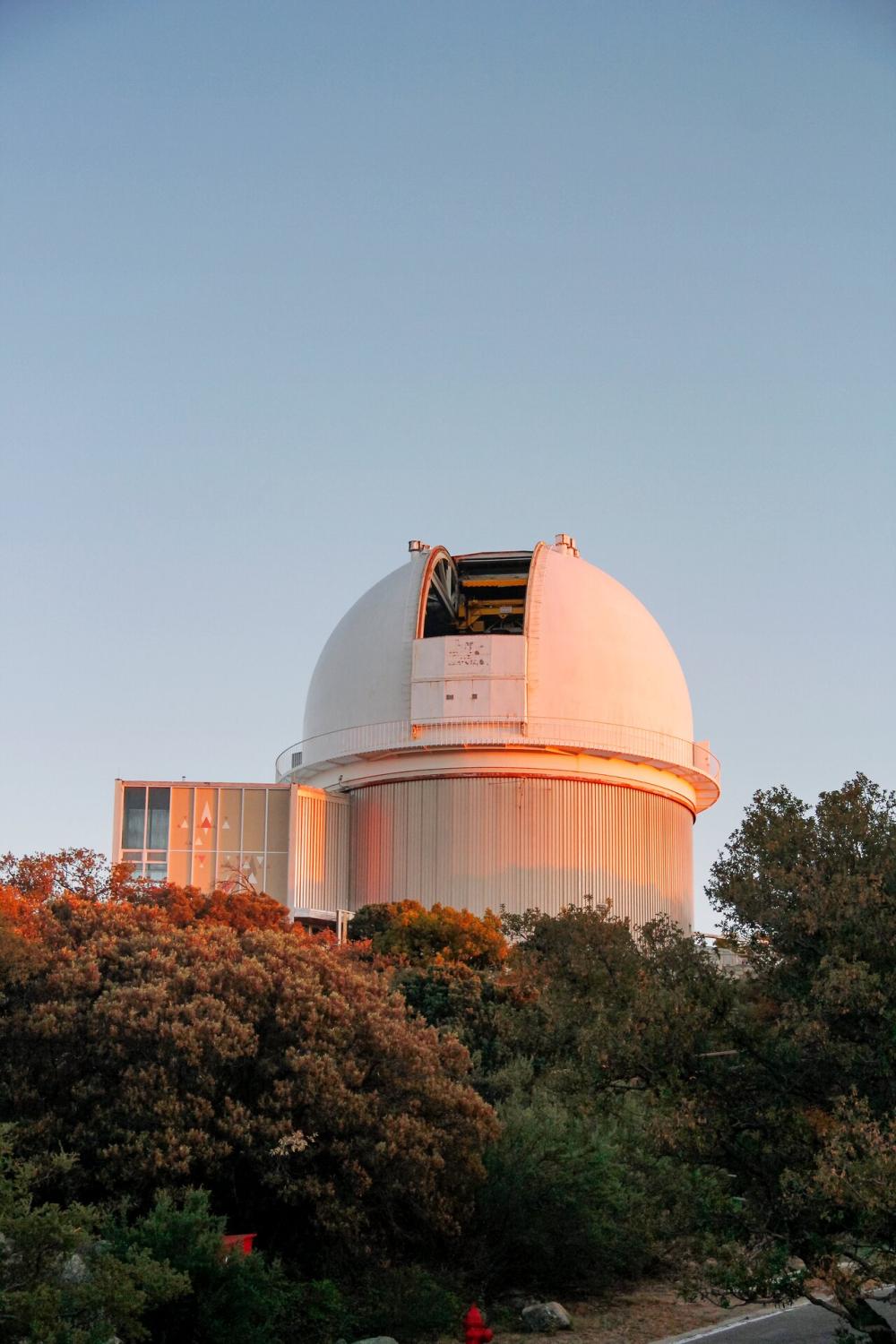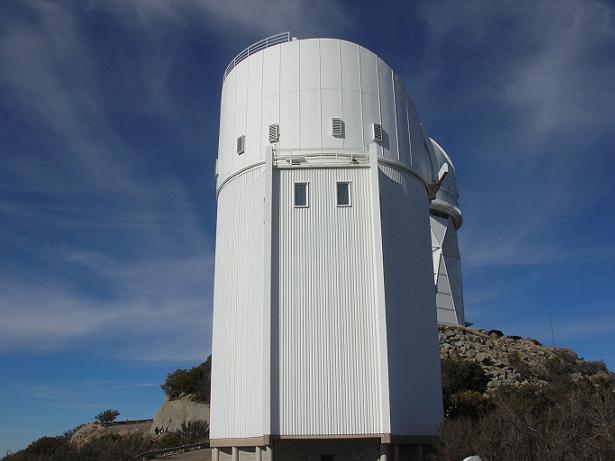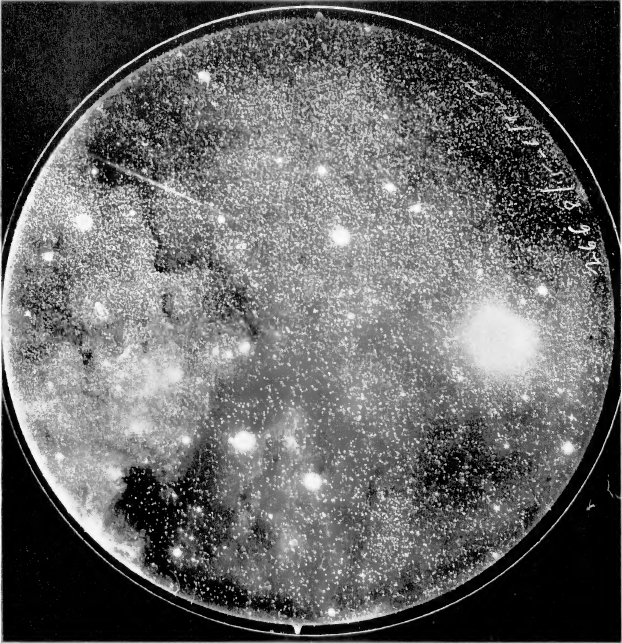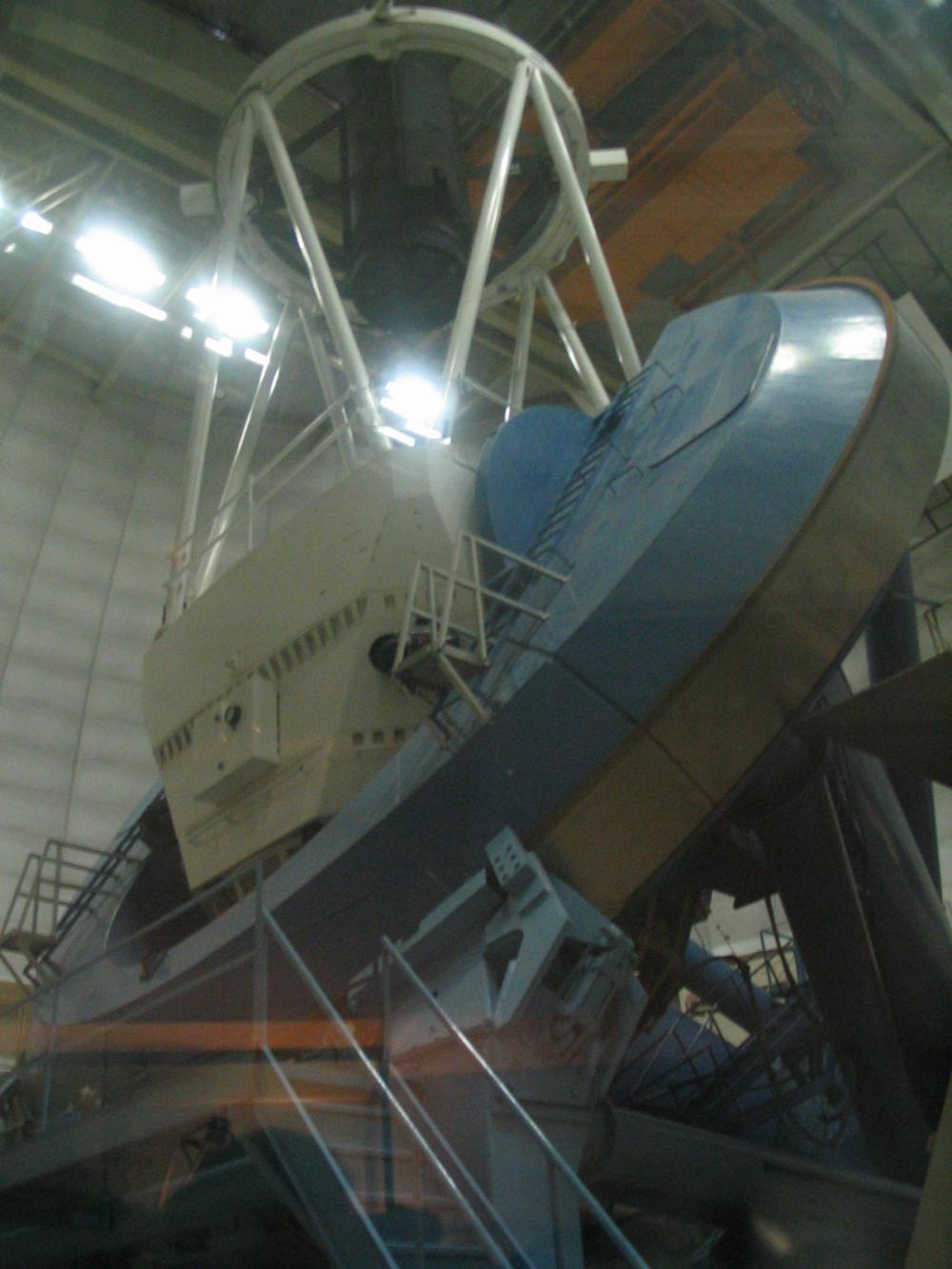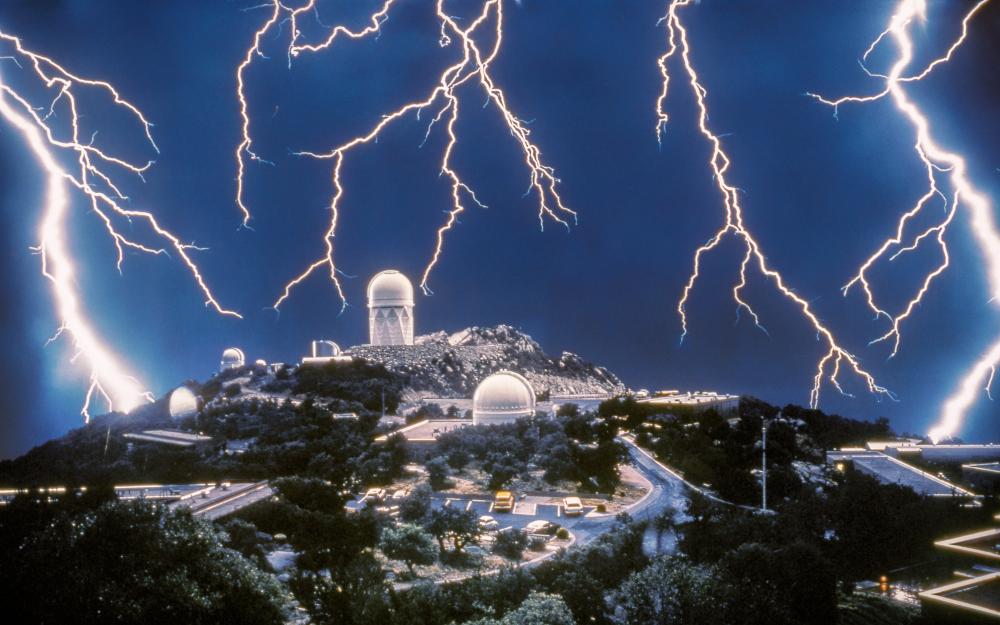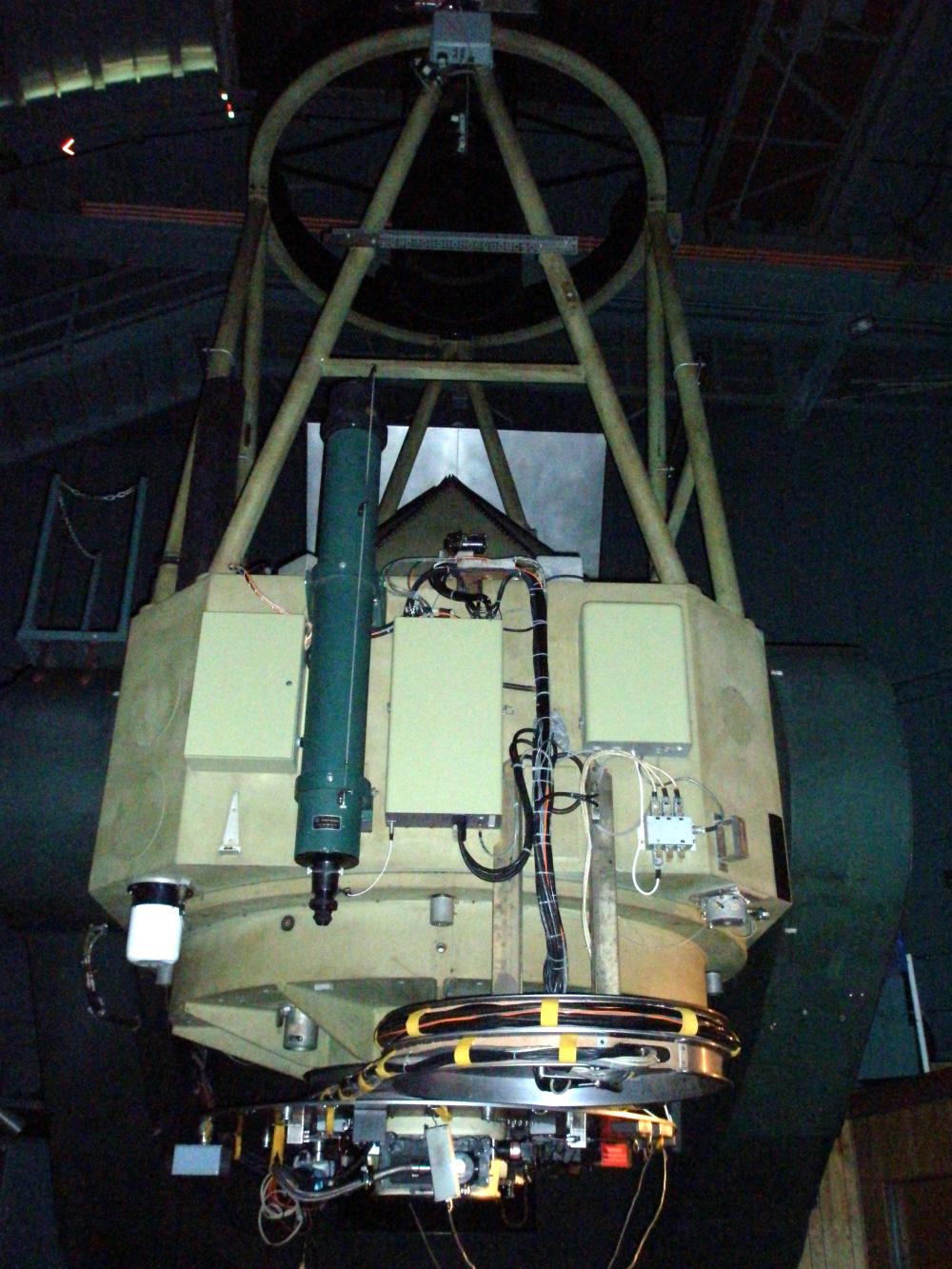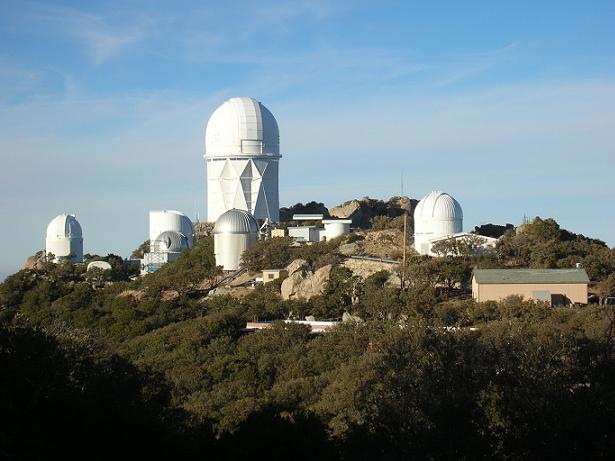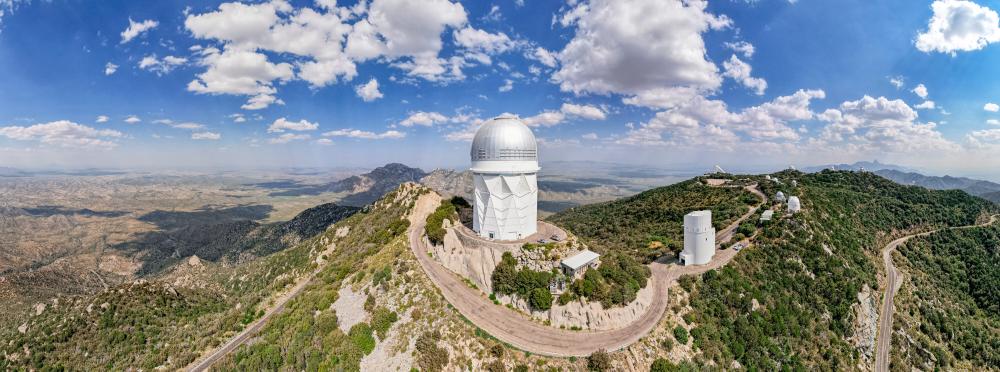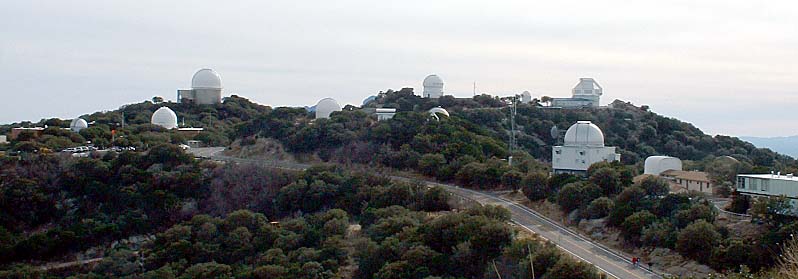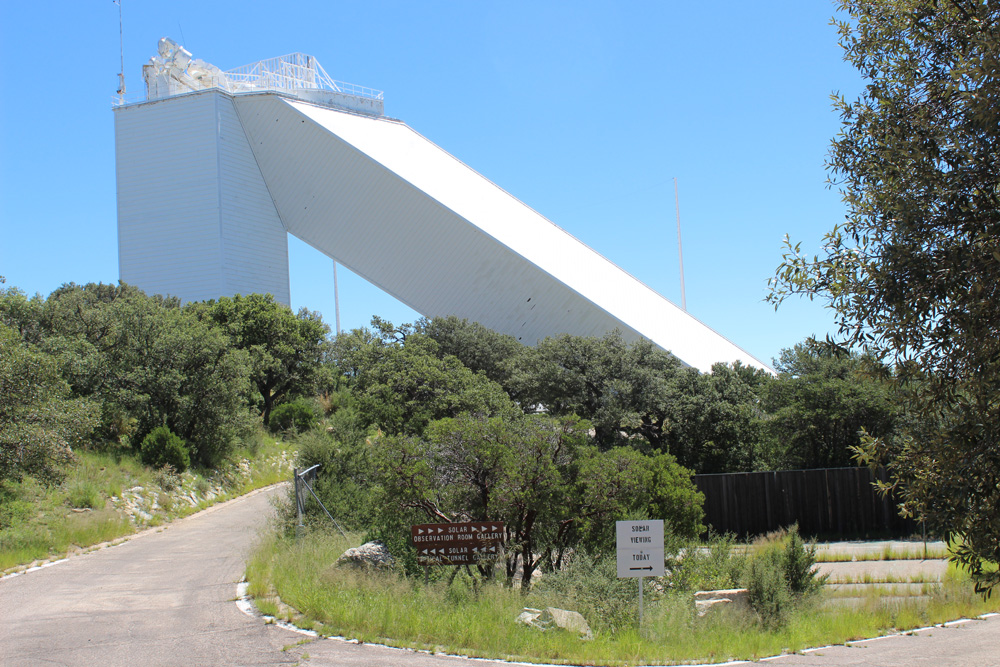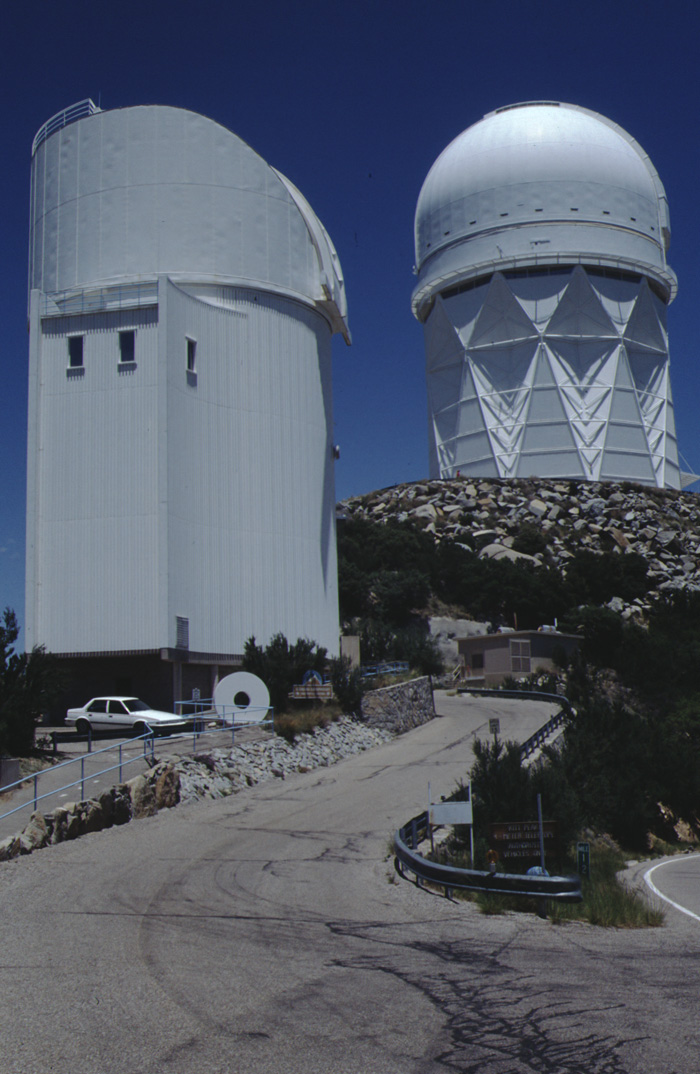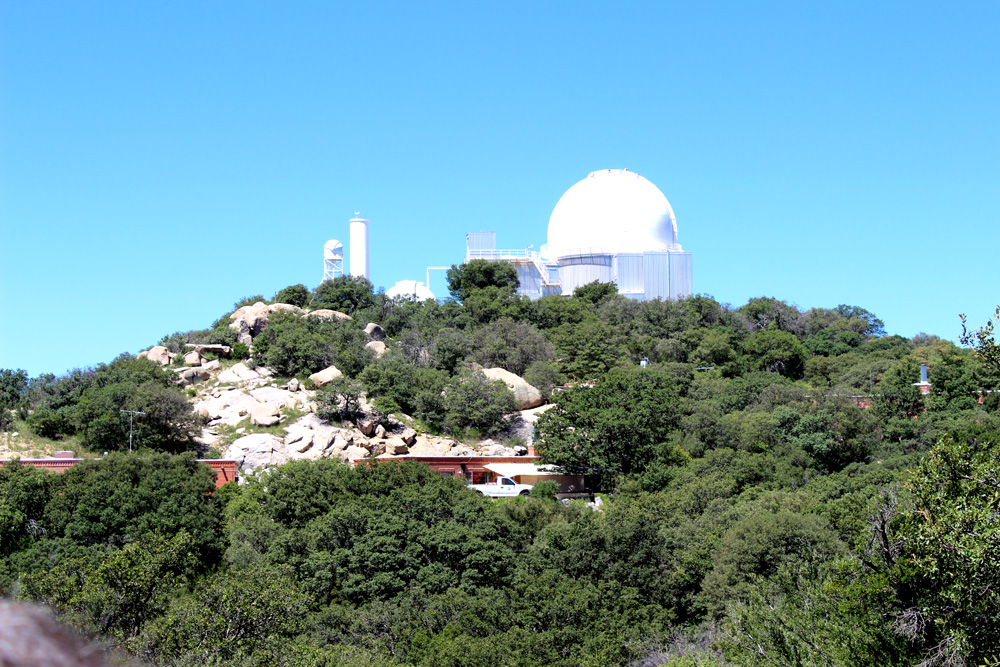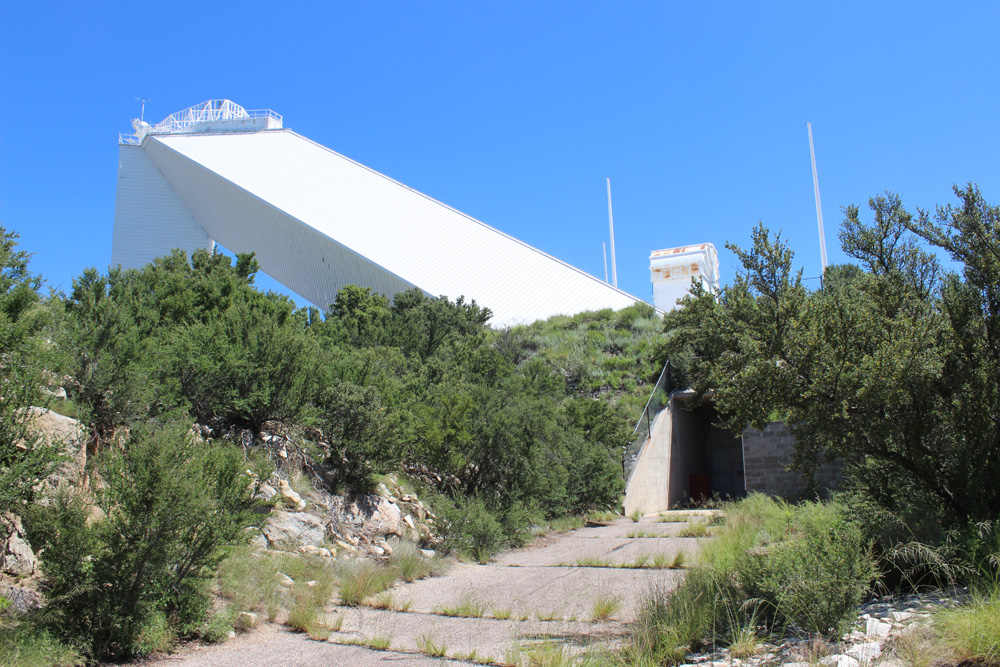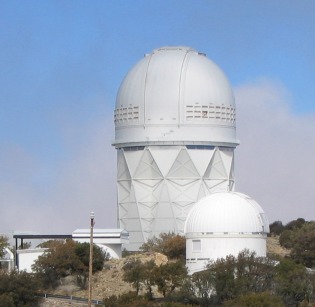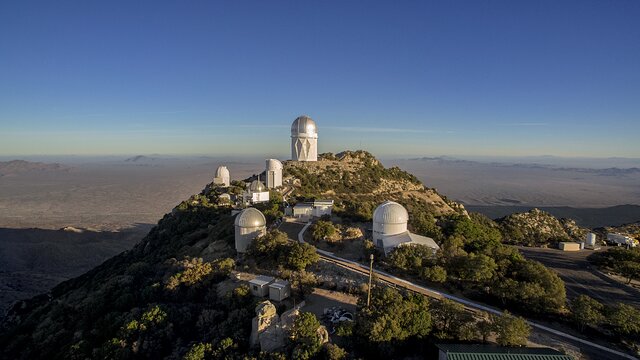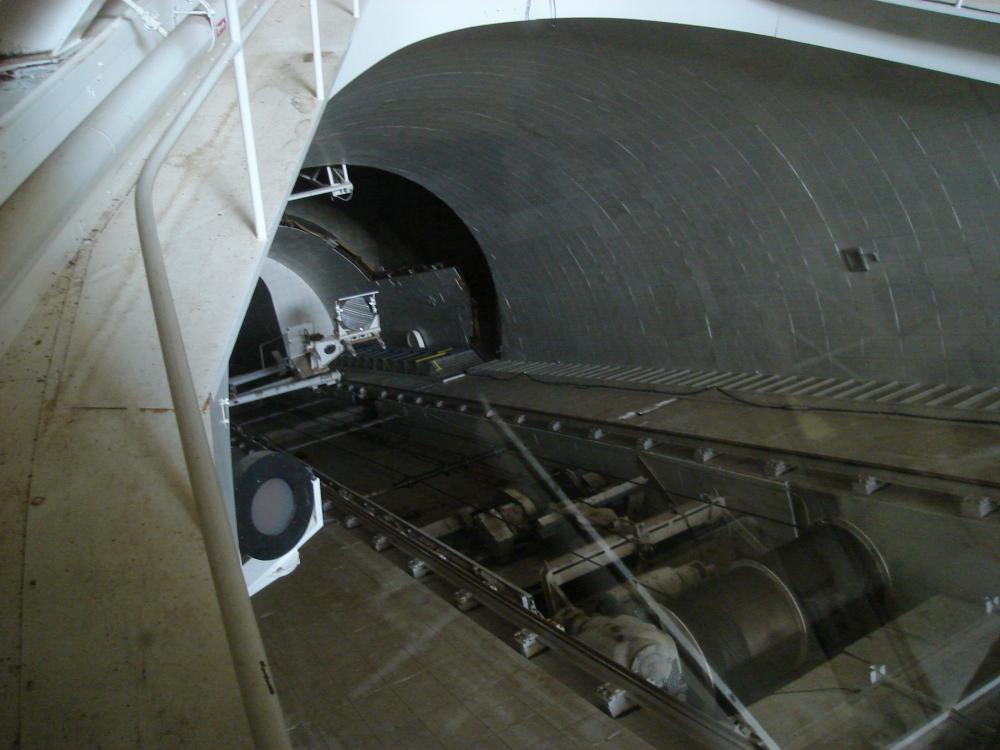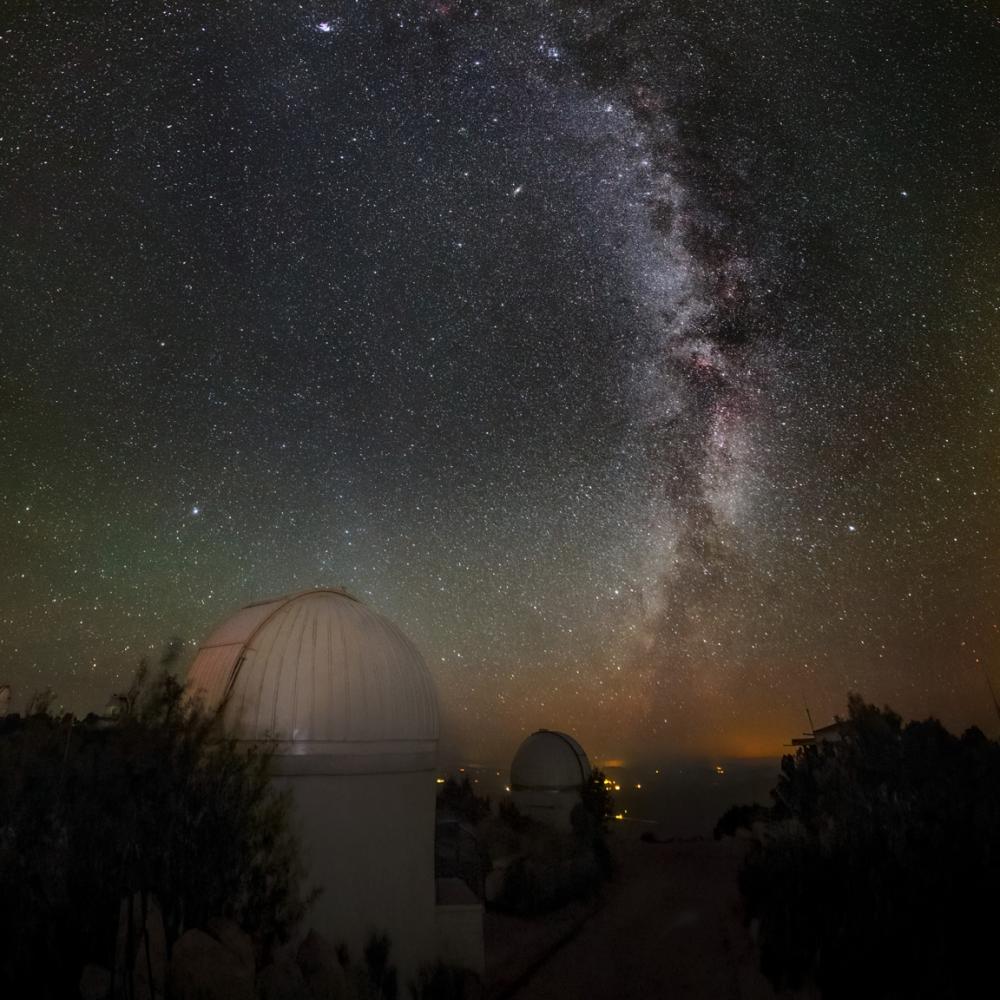
Category of Astronomical Heritage: tangible immovable
Kitt Peak National Observatory (KPNO, Tucson, Arizona, USA

Description
Geographical position
Kitt Peak National Observatory (KPNO), 950 N. Cherry Ave, Tucson, Arizona AZ 85719, USA
Location
Latitude 31°57'48'' N, Longitude 111°36'0'' W, Elevation 2095m above mean sea level.
IAU observatory code
695
Description of (scientific/cultural/natural) heritage
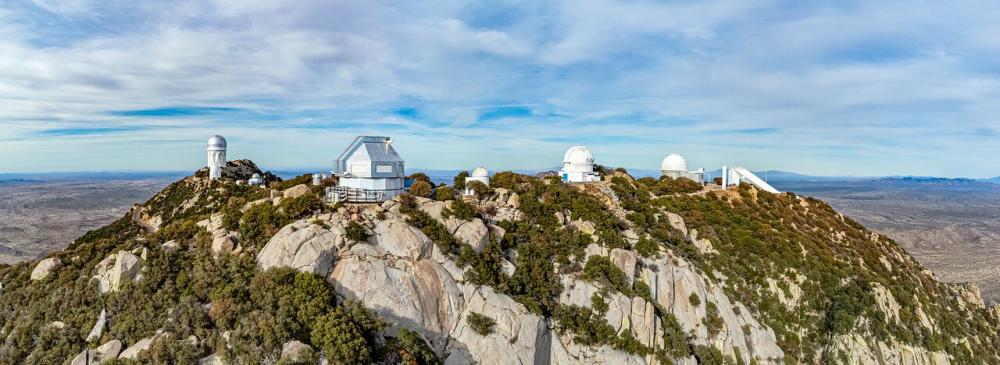
Fig. 1. Kitt Peak National Observatory (KPNO), a Program of NSF's NOIRLab (1958), (KPNO/NOIRLab/NSF/AURA/T. Matsopoulos)

Fig. 1b. Kitt Peak National Observatory (KPNO), (photo: Martina Kölbl-Ebert)
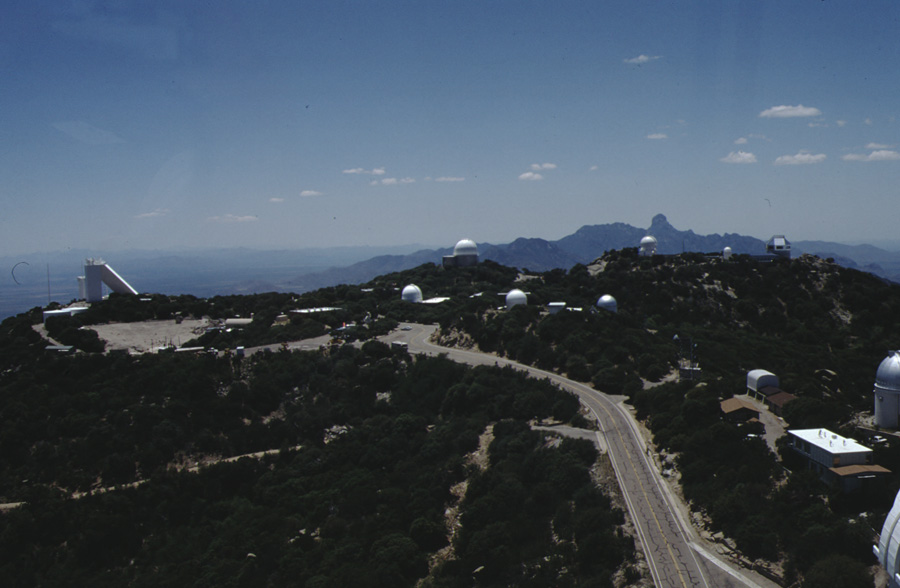
Fig. 1c. Overview: Kitt Peak National Observatory (KPNO), (photo: Martina Kölbl-Ebert)
Kitt Peak National Observatory (KPNO), a Program of NSF's NOIRLab, was founded in 1958, on Kitt Peak, the highest point in the Quinlan Mountains in the Arizona-Sonoran Desert on the Tohono O'odham Nation, 88 km (55 miles) southwest of Tucson, Arizona. The National Optical Astronomy Observatory (NOAO) was responsible for the administration from the 1980s until 2019, then by the NOIRLab.
This observatory houses one of the largest collections of optical and radio telescopes in the world: 24 optical and two radio telescopes.
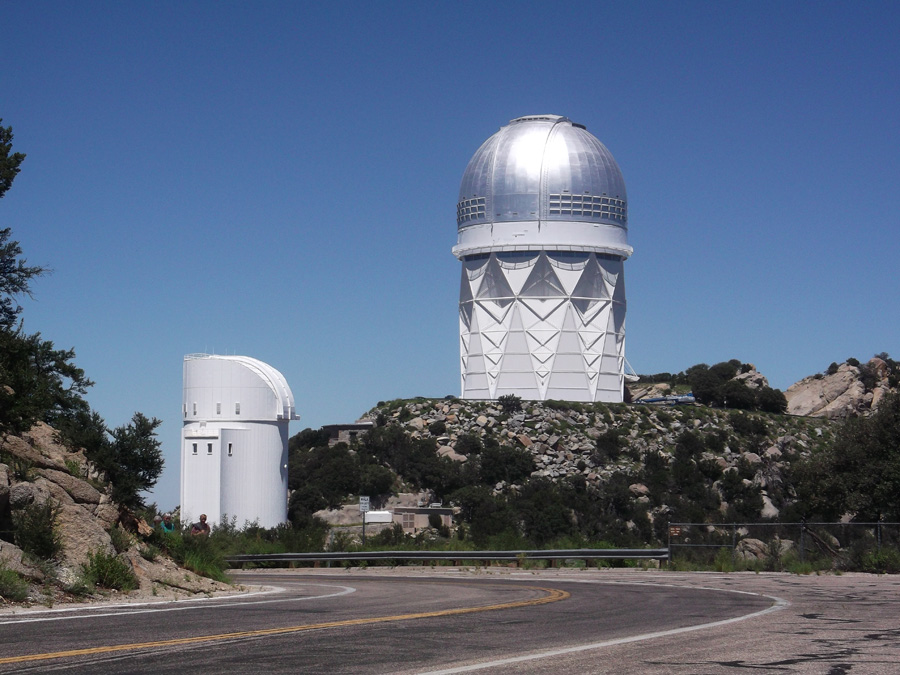
Fig. 2a. 4-m-Mayall Telescope, Kitt Peak National Observatory (KPNO), (photo: Martina Kölbl-Ebert)
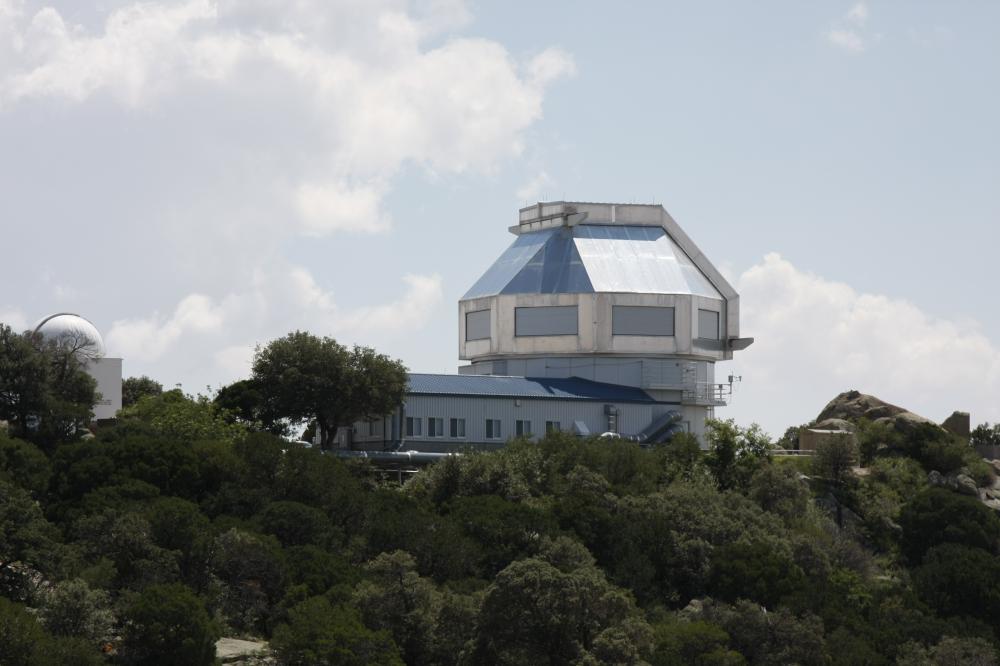
Fig. 2b. 3.5-m-WIYN CCD Nasmyth Telescope Dome, Kitt Peak National Observatory (KPNO), (CC2, Joerg Weingrill)
The Mayall Telescope and the WIYN Telescope are the largest, with primary mirrors measuring 4-m and 3.5-m in diameter.
The Spacewatch project operates two reflecting telescopes with a diameter of 1.8-m and 0.9-m for the observation of asteroids and comets, in particular for the detection of near-Earth objects.

Fig. 2c. McMath-Pierce, Kitt Peak National Observatory (KPNO), (photo: Martina Kölbl-Ebert)
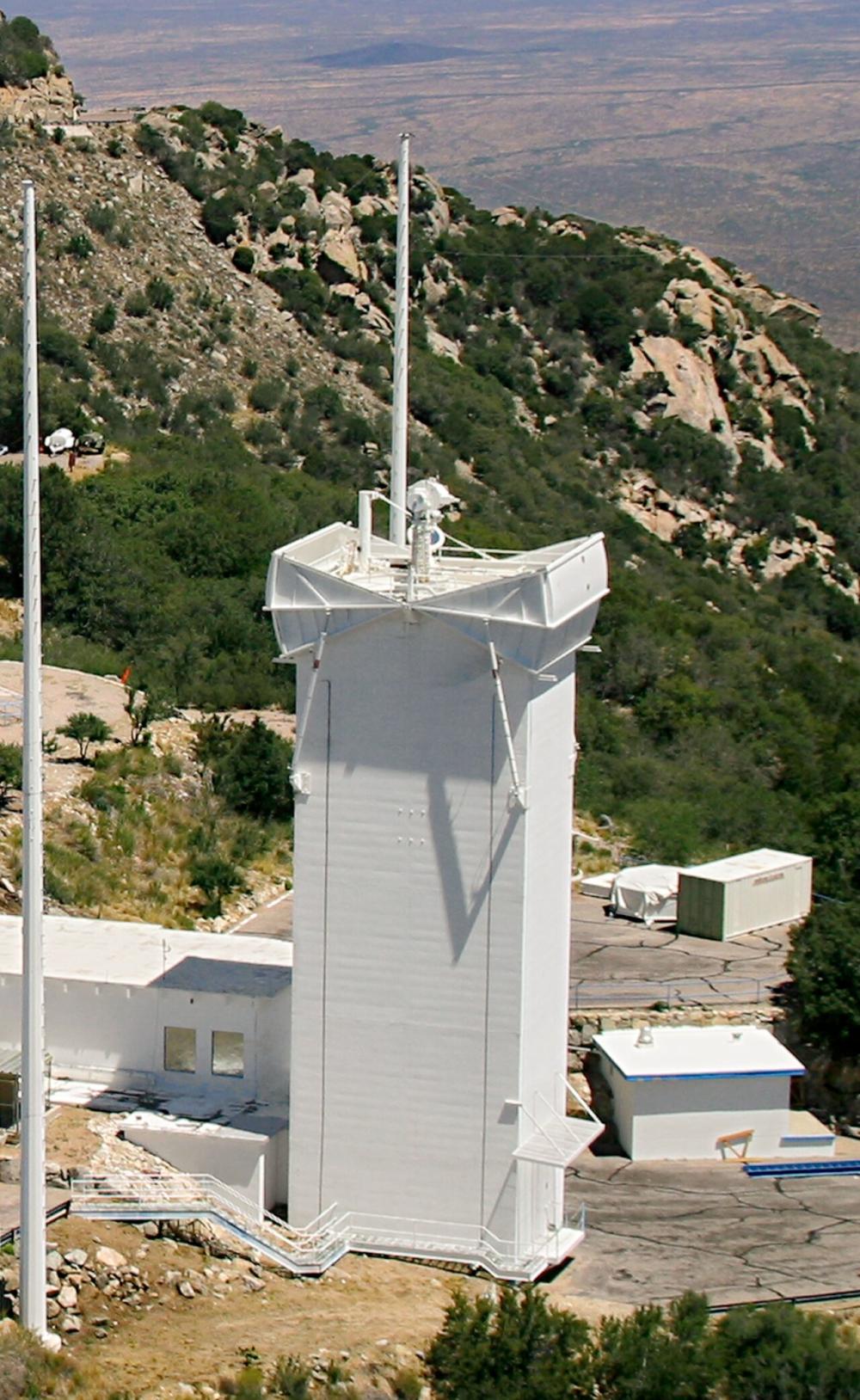
Fig. 2d. Kitt Peak Vacuum Telescope (KPVT), (credit: NOIRLab/NSF/AURA)
The McMath-Pierce Solar Telescope, the largest solar telescope in the world, and the Kitt Peak Vacuum Telescope are available at Kitt Peak for observing the Sun.
Finally, Kitt Peak also houses two radio telescopes with a diameter of 12-m and 25-m. The latter is used in conjunction with other radio telescopes in the Very Long Baseline Array as a radio astronomical interferometer.
Funding:
- Funded by National Science Foundation (NSF) -- NSF's NOIRLab (formally named the National Optical-Infrared Astronomy Research Laboratory) is the national center for nighttime astronomy.
- Built and operated by National Solar Observatory (Sacramento Peak and Kitt Peak)
- One of the National Optical Observatories
- Operated by Association of Universities for Research in Astronomy, Inc. (AURA)
Highlights of discoveries include
- Discovery of methane ice on Pluto (1976) with the 4-m Mayall Telescope
- Discovery of 20000 Varuna, a Kuiper belt body object (2000) with the 90 cm Spacewatch telescope, and by an astronomer using a blink comparator.
History

Fig. 3a. 24-inch-Schmidt-Burrell-Telescope, drawing by Russell Porter, Kitt Peak (Nassau 1945)
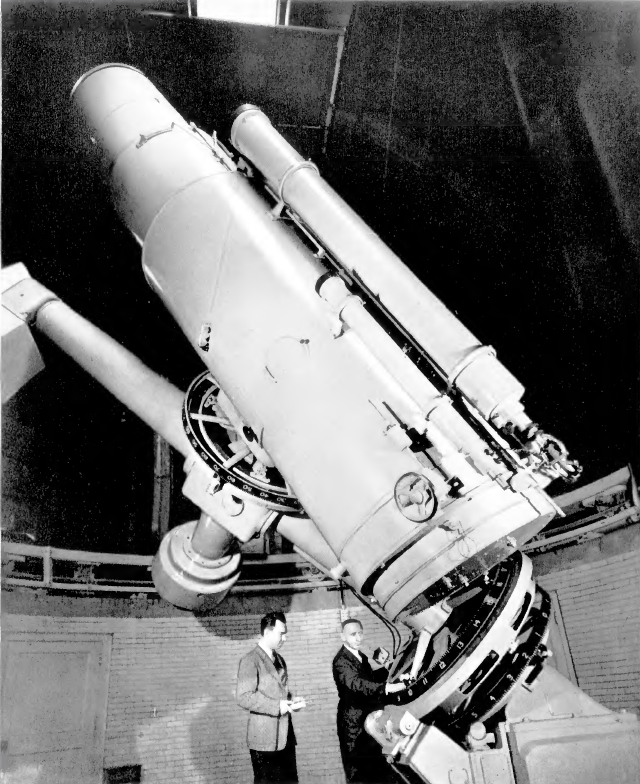
Fig. 3b. 24-inch-Schmidt-Burrell-Telescope, made by Warner & Swasey (1941), (Nassau 1945)

Fig. 3c. 24-inch-Schmidt-Burrell-Telescope, drawing by Russell Porter, Kitt Peak (Nassau 1945)
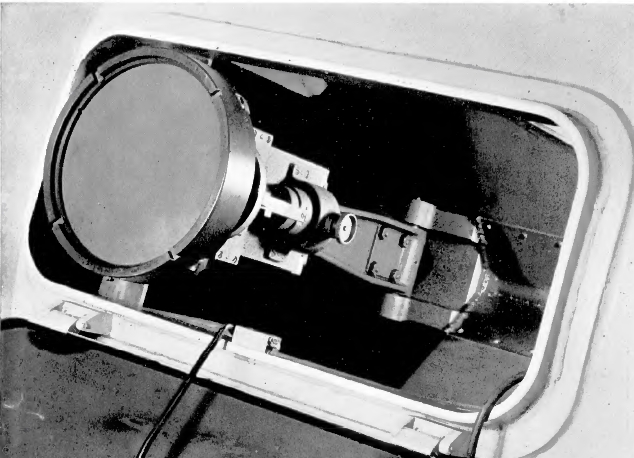
Fig. 3d. 24-inch-Schmidt-Burrell-Telescope, plateholder (Nassau 1945)
Instruments of Kitt Peak Observatory
Reflecting Telescopes
- 60-cm (24-inch) Schmidt "Burrell" Telescope, optics and mounting (cross-axis type) made by Warner & Swasey Company of Cleveland, Ohio (1941), with a 90-cm (36-inch) Pyrex-glass mirror blankmade by the Corning Glass, grounded and polished at Warner and Swasey, coated with chromium-aluminium (radius of curvature 168-inch). The Schmidt Telescope was tested by a method suggested by Dr. James G. Baker.
Burrell was the chief engineer of Warner & Swasey.
24-inch Objective prism, flint (DF-2) glass, 4°, made by Bausch and Lomb, Dispersion at H-gamma 283 Å/mm - 4-m (160-inch) Ritchey-Chrétien reflector (f/2.7) -- Nicholas U. Mayall Telescope (1973),
named after Nicholas Ulrich Mayall (1906--1993) - 3.5-m (138-inch) Ritchey-Chrétien reflector (1994) -- WIYN Telescope, focal length 6.1-m, altazimuth mount, rhombicuboctahedron enclosure,
WHIRC -- a near infrared high resolution imaging camera (2008)
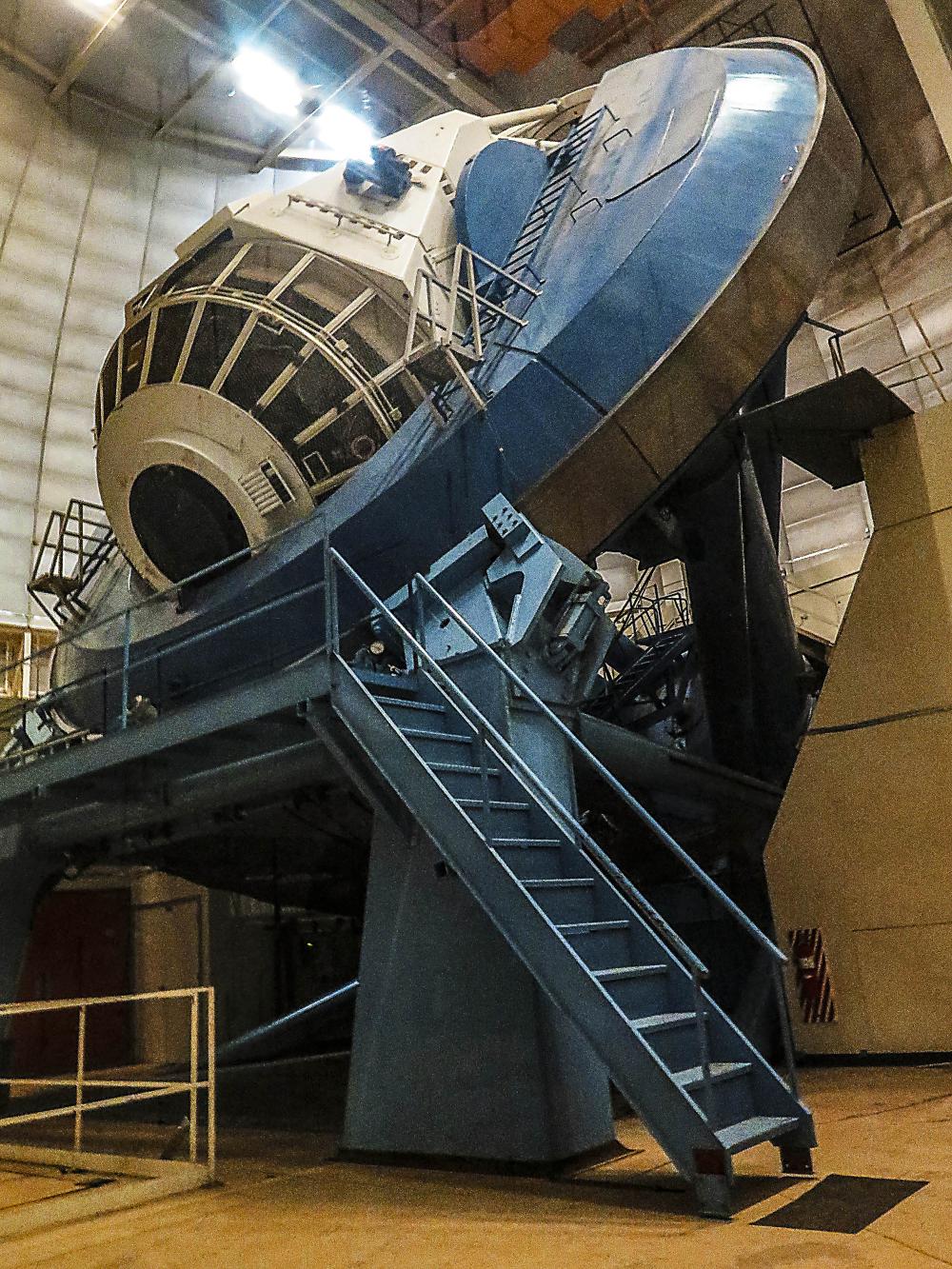
Fig. 4a. 4m-Mayall-telescope, Kitt Peak (CC4, Burley Packwood)
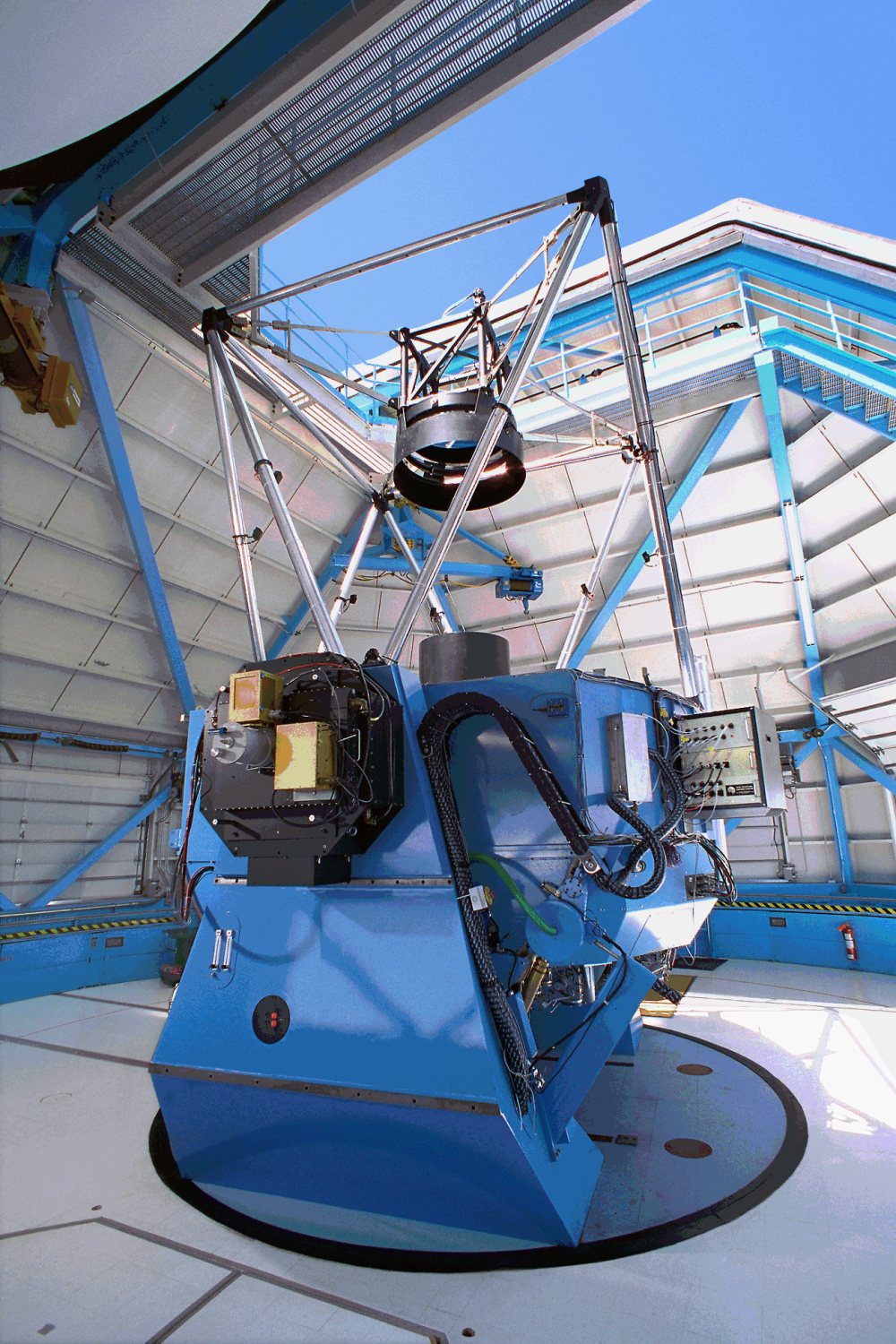
Fig. 4b. 3.5-m-WIYN CCD-Nasmyth (KPNO)
- 2.1-m (84-inch) Telescope (1964) -- fourth largest telescope on the mountain
- 2.3-m (90-inch) Bok Telescope (1969), operated solely by Steward Observatory, named after Bart Bok (1906--1983)
- Coudé Feed Tower -- Coudé spectrograph
- Super-LOTIS, designed to look for visible signatures of GRBs
- 1.8-m reflecting telescope, 72-inch mirror, Spacewatch project: for the observation of asteroids and comets, in particular for the detection of near-Earth objects (NEO)
- 0.9-m (36-inch) reflecting telescope, Spacewatch project: for the observation of asteroids and comets, in particular for the detection of near-Earth objects (NEO)
- SARA Observatory 0.9-m telescope, Variable stars, undergraduate training
- RCT Consortium Telescope, robotically controlled
- WIYN 0.9-m (36-inch) Telescope, for the study of Galactic studies
- SOLARIO remote telescope for Astrophotography
- 1.3-m McGraw-Hill Telescope, MDM Observatory, originally at Ann Arbor
- 2.4-m Hiltner Telescope, MDM Observatory, used for Galactic surveys
- DIMM all-sky camera, monitors seeing
- Visitor Center telescopes, three instruments used for nightly public programs
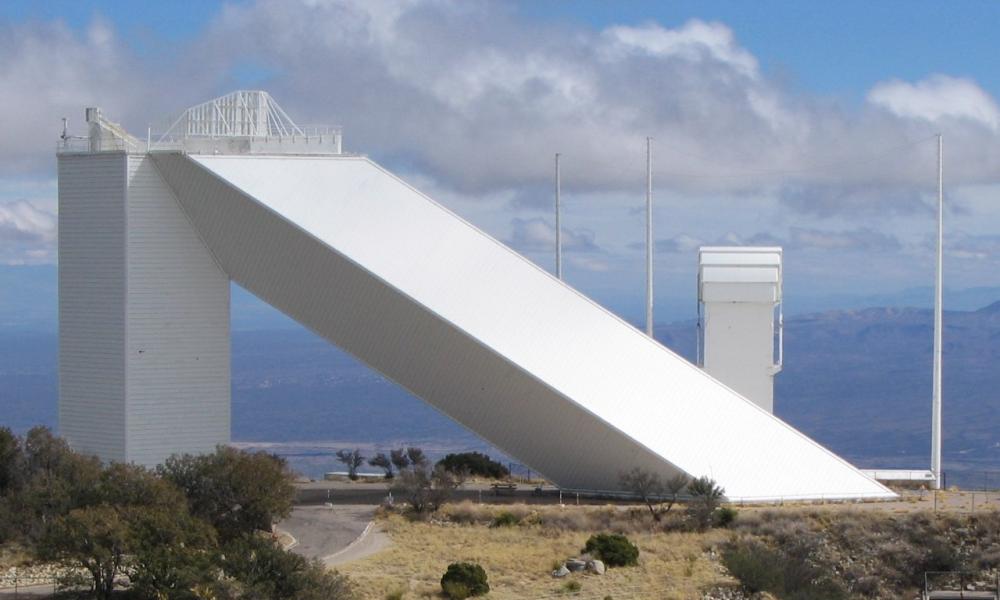
Fig. 5a. McMath-Pierce-Solar-Telescope, Kitt Peak (CC2.5, John Owens)
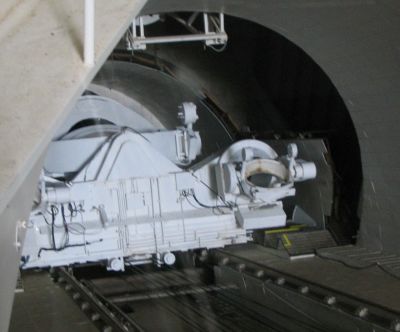
Fig. 5b. inside of the McMath-Pierce-Solar-Telescope, Kitt Peak (CC2.5, John Owens)
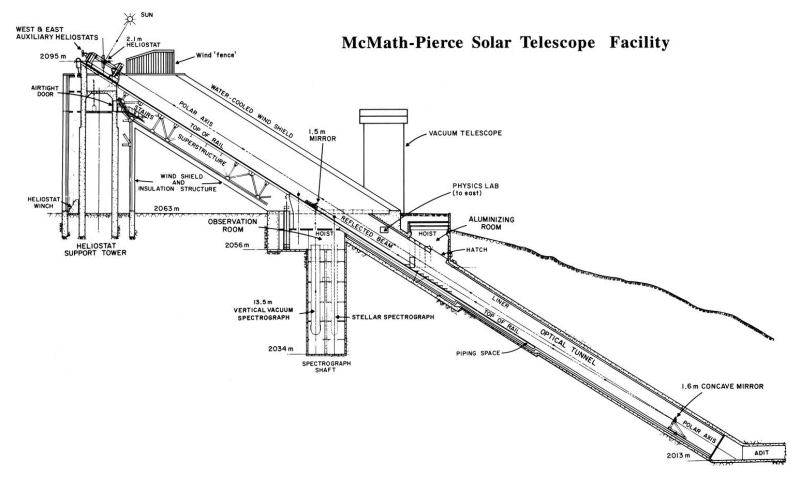
Fig. 5c. McMath-Pierce Solar Telescope, cross-section (CC)
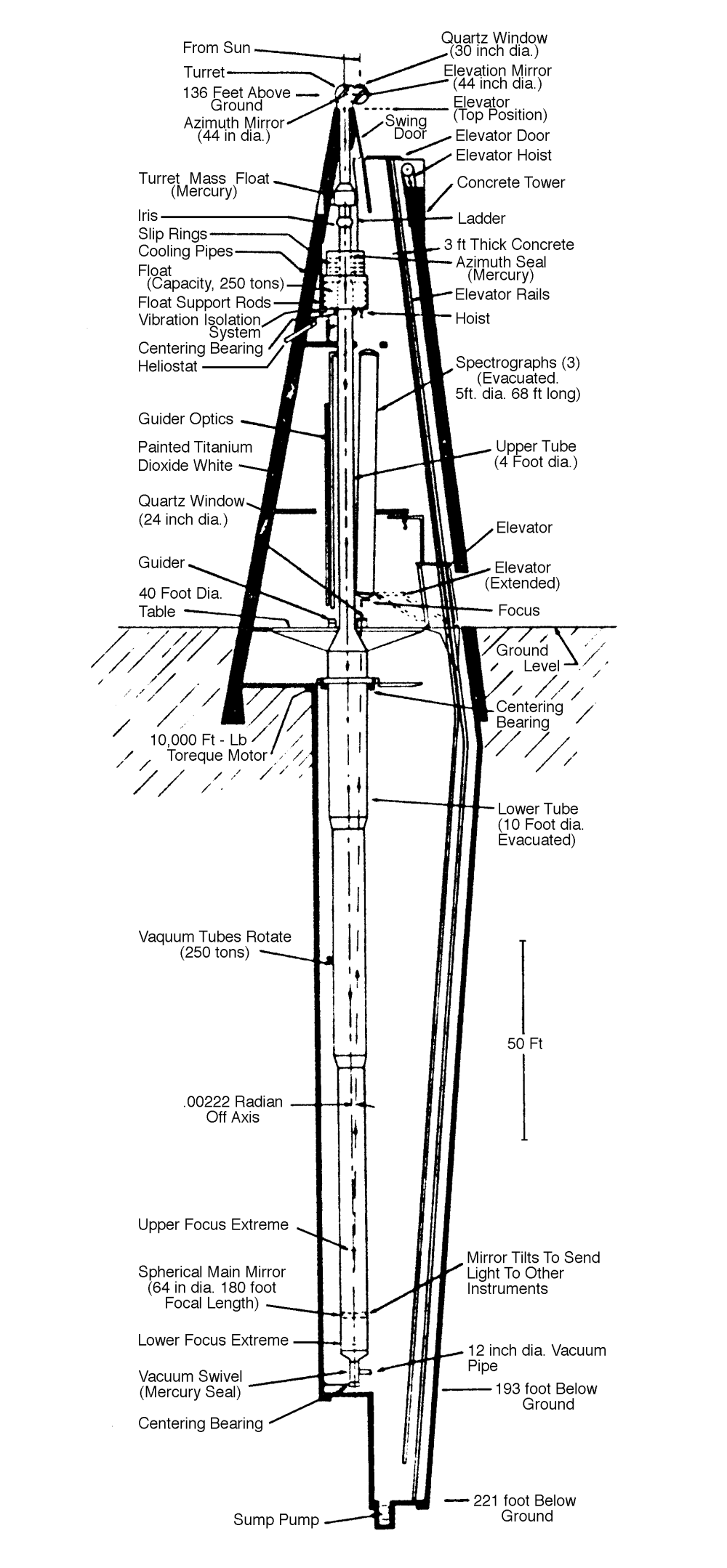
Fig. 5d. Kitt Peak Tower Telescope, cross-section (CC)
Solar Telescopes
- 1.6-m solar reflector (f/54) -- McMath-Pierce Solar Telescope (1962) -- the largest solar telescope in the world.
The McMath-Pierce Solar Telescope was named after the astronomers Robert Raynolds McMath (1891--1962), first president of Association of Universities for Research in Astronomy (AURA) from 1957 to 1958, and Keith Pierce (1918--2005), director of the solar division, and
designed by the American architect a student of Mies van der Rohe and Pier Luigi Nervi, partnerof Skidmore, Owings & Merrill from 1955 to 1983, and by the engineer Fazlur Rahman Khan (1929--1982), "Einstein of structural engineering", in 1955 employed, in 1966 partner in the firm Skidmore, Owings & Merrill in Chicago - Kitt Peak Vacuum Telescope
- NEID Solar Telescope, obtains disk-integrated light for a spectrograph
- Coronado Array, three commercially produced Meade/Coronado solar instruments used for public education
- two 0.9.m auxiliary solar telescopes
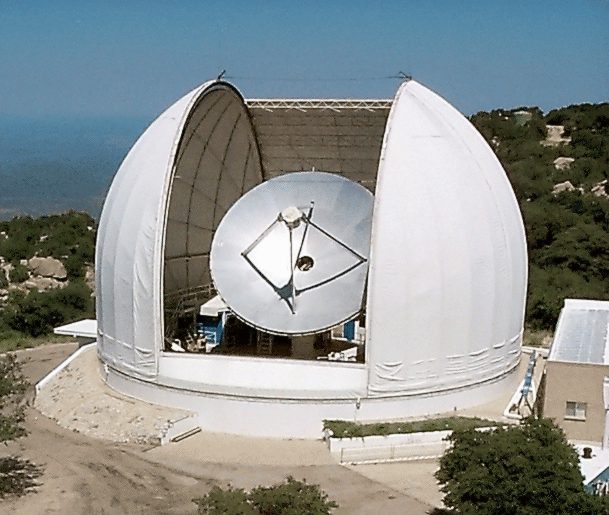
Fig. 6a. 12m-dish Radiotelescope (CC3, Jeff Mangum, NRAO)
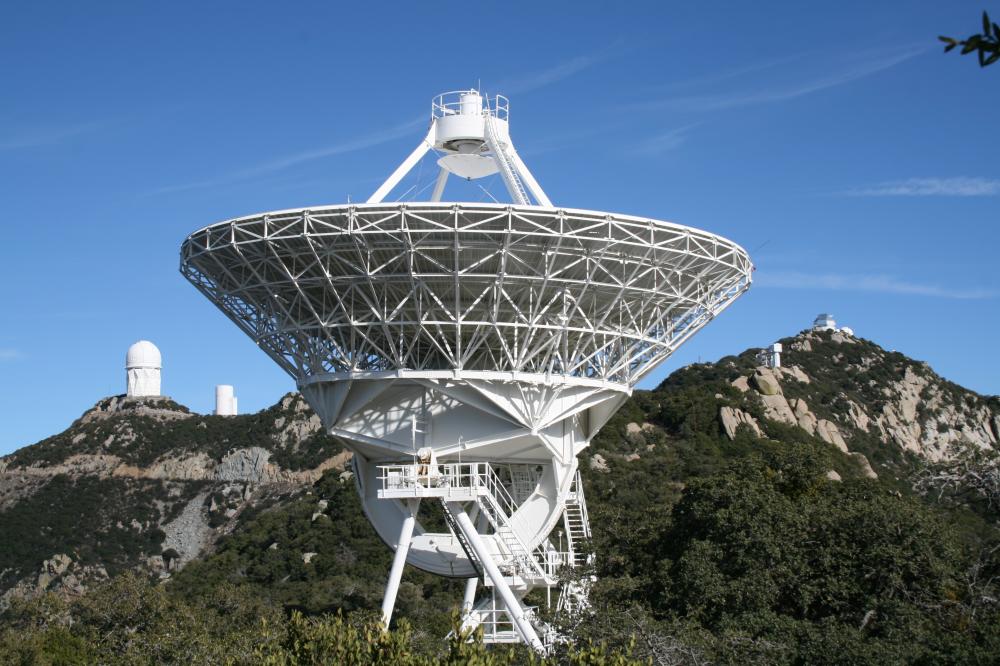
Fig. 6b. 25m-Radiotelescope VLBA (CC3, kallahar)
Radio Telescopes
- 12-m Radio telescope, ARO, one of two telescopes operated by the Arizona Radio Observatory, part of Steward Observatory
- 25-m Radio telescope, radio astronomical interferometer, one of ten radio-telescopes of the Very Long Baseline Array (VLBA)

Fig. 7a. Nicholas Ulrich Mayall (1906--1993) at the 4-m, (CC4, Tom Eglin, NOIRLab)
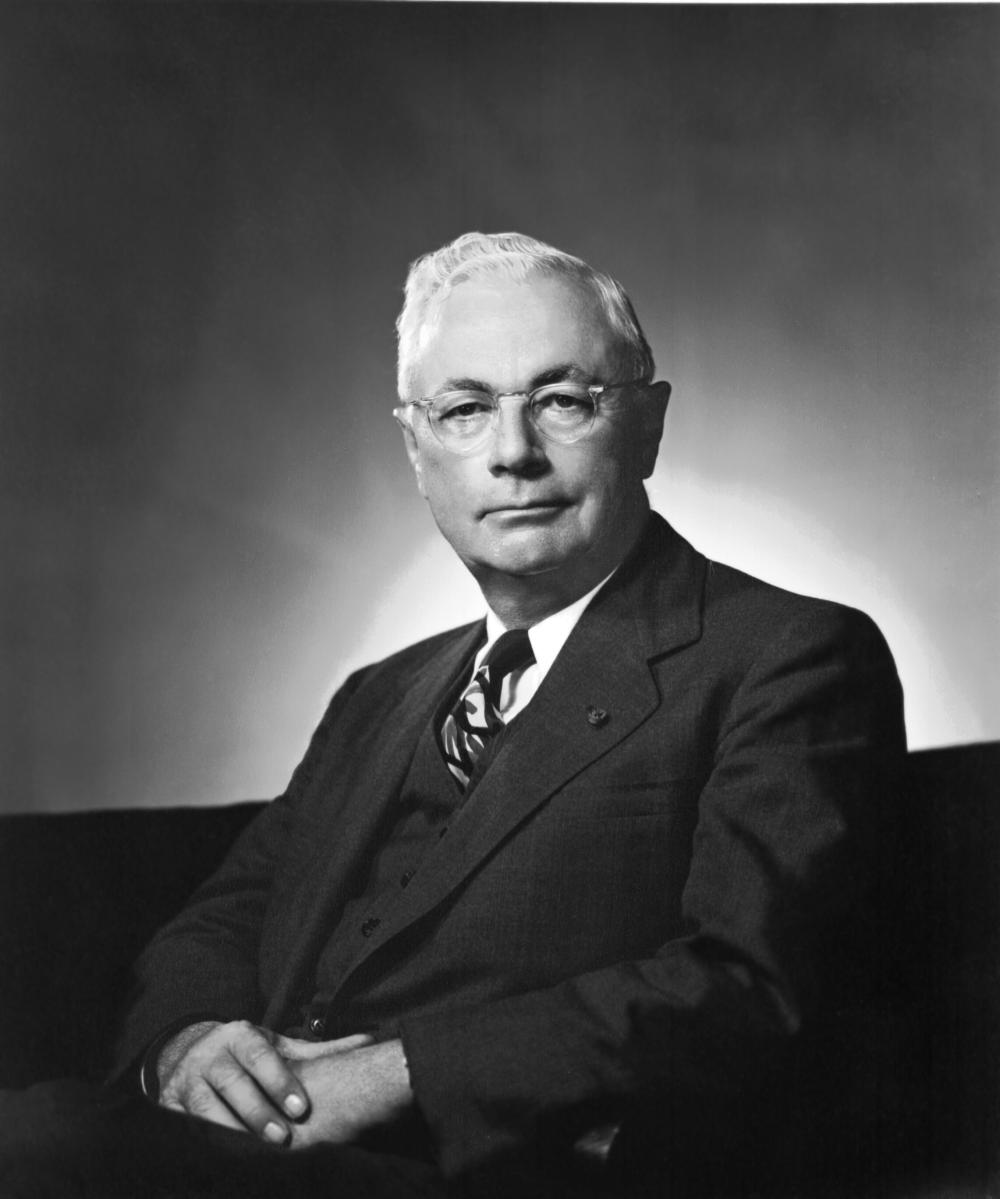
Fig. 7b. Robert Raynolds McMath (1891--1962) (CC4, Robert McMath, NOIRLab)
Directors of Kitt Peak Observatory
- 1958 to 1960 -- Aden B. Meinel (1922--2011)
- 1960 to 1971 -- Nicholas Ulrich Mayall (1906--1993)
- 1971 to 1977 -- Leo Goldberg (1913--1987)
- ...
State of preservation
Kitt Peak is well preserved. But in June 2022, the Contreras Fire destroyed four non-scientific buildings, including a dormitory.
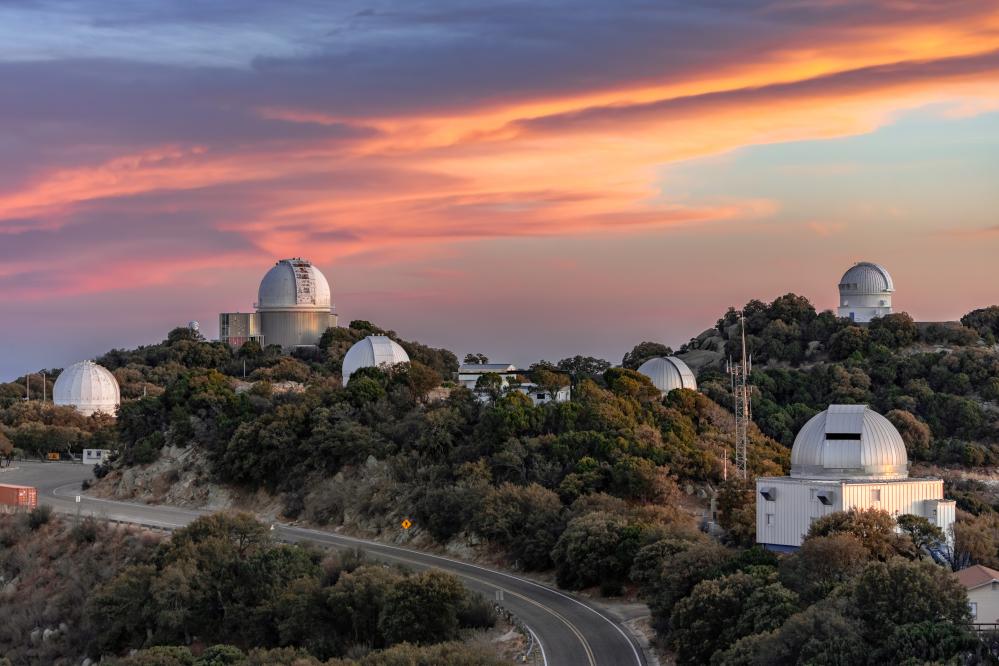
Fig. 8a. Kitt Peak Observatory at sunset (KPNO, NOIRLab, T. Slovinsky)
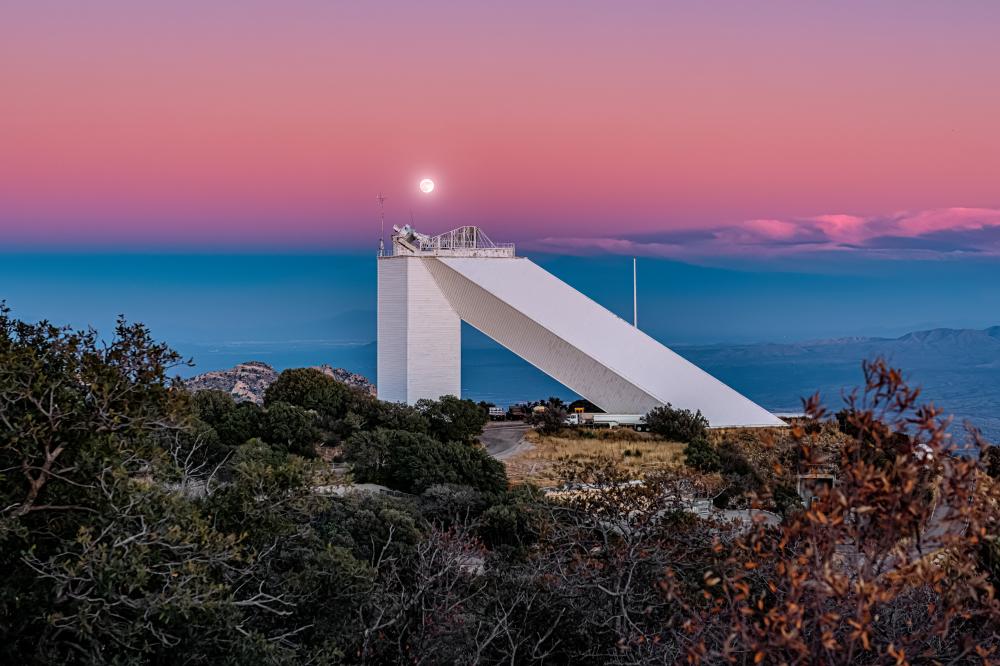
Fig. 8b. Venus over McMath-Pierce (KPNO, NOIRLab, P. Horalek)
Comparison with related/similar sites
Solar telescopes ....
Threats or potential threats
no threats
Present use
Kitt Peak is engaged in a variety of public outreach and education programs.
Astronomical relevance today
The topics of astronomical research are the study of dark matter (Dark Energy Spectroscopic Instrument (DESI), 2010s, for the 4-m Mayall telescope), cosmic distances, high-redshift galaxies, and the Bootes Void.
References
Bibliography (books and published articles)
- Nassau, J. J.: The Burrell Telescope of the Warner and Swasey Observatory. In: Astrophysical Journal 101 (May 1945), p. 275-279.
- Robert R. McMath. In: Physics Today 15 (June 1962), 6, p. 94.
- Wolfschmidt, Gudrun: Development of Solar Tower Observatories.
In: Astronomische Nachrichten - Astronomical Notes 324 (2003), Supplementary Issue 3, S. 92-93. - Wolfschmidt, Gudrun (Hg.): Sonnenphysik im Zweiten Weltkrieg - Wissenschaft oder Kriegsforschung? In: Meinel, C. & P. Voswinckel (ed.): Medizin, Naturwissenschaft, Technik und Nationalsozialismus - Kontinuitäten und Diskontinuitäten. Stuttgart: Verlag für Geschichte der Naturwissenschaften und der Technik 1994, p. 152-159.
- Wolfschmidt, Gudrun: Development of Solar Tower Observatories. In: Development of Solar Research. Entwicklung der Sonnenforschung. Proceedings of the Colloquium. Freiburg (Breisgau), September 15, 2003. Edited by Axel Wittmann, Gudrun Wolfschmidt & Hilmar Duerbeck. Frankfurt am Main: Harri Deutsch (Acta Historica Astronomiae Vol. 25) 2005, p. 169-198.
- Wolfschmidt, Gudrun: B1. Astronomical Heritage - Solar Observatories and Instruments, 17th to 19th Century. In: Astronomy and World Heritage: Across Time and Continents. Proceedings of the UNESCO Conference Kazan, August 2009. Ed. by Mikhail Ya. Marov. Associate Scientific Editors: Olga B. Dluzhnevskaya, Jarita C. Holbrook, Viktor K. Abalakin, Yuri A. Nefedyev, Tamila M. Potyomkina. International Astronomical Union, UNESCO. Kazan: Publishing House of Kazan University 2016, p. 172-177.
- Wolfschmidt, Gudrun: B2. Astronomical Heritage - evelopment of Modern Solar Tower Observatories, 20th Century. In: Astronomy and World Heritage: Across Time and Continents. Proceedings of the UNESCO Conference Kazan, August 2009. Ed. by Mikhail Ya. Marov. Associate Scientific Editors: Olga B. Dluzhnevskaya, Jarita C. Holbrook, Viktor K. Abalakin, Yuri A. Nefedyev, Tamila M. Potyomkina. International Astronomical Union, UNESCO. Kazan: Publishing House of Kazan University 2016, p. 178-187.
Links to external sites
- Kitt Peak National Observatory (KPNO)
- Kitt Peak National Observatory (Wikipedia)
- McMath-Pierce solar telescope
- Fazlur Rahman Khan (1929--1982) (Wikipedia)
- Myron Goldsmith (1918--1996) (Wikipedia)
- Robert Raynolds McMath (1891--1962) (Wikipedia)
- Keith Pierce (1918--2005) (Wikipedia)
- Nicholas U. Mayall Telescope (Wikipedia)
- Nicholas Ulrich Mayall (1906--1993) (Wikipedia)
- 3.5-m (138-inch) Ritchey-Chrétien reflector (1994) -- WIYN (Wikipedia)
- Bok Telescope (Wikipedia)
- Bartholomeus Jan "Bart" Bok (1906--1983) (Wikipedia)
- In Memoriam: Aden Meinel, founder of Kitt Peak National Observatory (SPIE)
- Aden Meinel (Wikipedia)
- Aller, Lawrence H.: Leo Goldberg (1913--1987), Biographical Memoirs, Vol. 72. Washington, DC: The National Academies Press (1997)
- Leo Goldberg (Wikipedia)
- ...
Links to external on-line pictures
no information available
No multimedia content published
Currently there is no multimedia content published for this case study








